Hawaii has a unique and diverse population, people settling from a wide variety of places brought their culture and their foods to the islands. Now when visiting Hawaii you’ll see that many food items that aren’t popular or even found in other parts of America are incredibly popular on the island.
Below are some of the more interesting and unique foods that not only will you not find in Hawaii but should seek out and enjoy.
Spam

Photo credit: Bandita
Most Americans are familiar with SPAM, the salty porky canned meat but not many are used to eating it or would even dream of letting it pass their lips. Interestingly enough in Hawaii it is not only common but well loved, and for good reason, as if done right it’s outstanding. Popularized during World War II when fishing was prohibited, Islanders turned to this meat high in protein. Hawaii is the seond largest consumer of SPAM in the world after Guam. Made by Hormel company you can find it prepared in a wide variety of ways, most popularly seen as Spam Musubi, rice topped with a piece of fried spam and wrapped with Seaweed. Also it’s commonly served fried for breakfast. It’s not only cheap but also delicious and can be found at any grocery store in the US, if you haven’t tried yet, there’s no time like the present. It’s not hard to make and inexpensive, here’s a recipe to get you started. How to Make Spam Musubi.
Poke
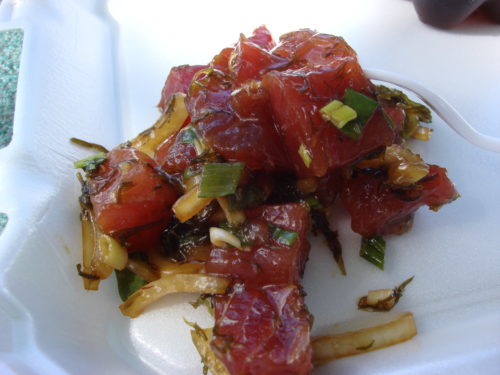
Photo credit: Gregg Tavares
Go to any big grovery store in Hawaii and head over to the section of the store where seafood is sold and you’re likely to find a Poke bar. Poke is commonly made with tuna but can also be made from a wide variety of seafood from mussels to squid and octopus. The seafood is frequently served raw after being marinated in a combination of seasonings such as soy sauce, sesame oil, seaweed and onion. While on the mainland it is difficult to find fresh seafood. But there’s nothing like going to a Poke Bar in Hawaii and picking out a variety of poke to take the beach.
Poi
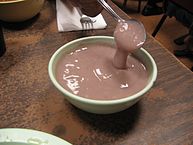
If you’ve been to a luau in Hawaii you’ve likely experience poi. Poi is a paste made from the taro root and was popular stable for early hawaiians and is still commonly eaten by locals, particularly at luaus. Many enjoy it as a nice counterbalance to rich fatty foods like kalua pork. It’s light purple color and pasty texture make it unpopular among non-locals. It can be found at most grocery stores on any Hawaiian Island. While you likely wouldn’t make a habit of eating it, as with most unique foods, it’s worth a try. Many locals recommend adding a bit of sugar to enhance the flavor.
Kalua Pig
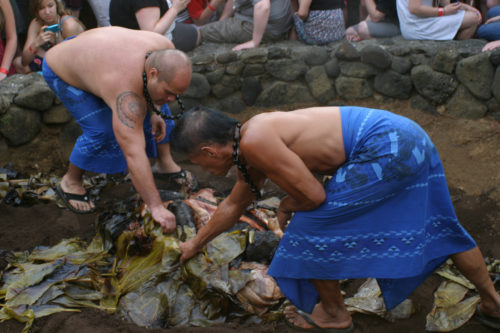
Photo Credit: Karen
Pork is a common food in Hawaiian cuisine and is often prepared in a variety of ways however Kalua pig is the most fun, interesting and many would argue the most delicious. Kalua pig involves cooking the entire pig as one whole piece. A large hole is dug then hot rocks are placed in the bottom of the rocks before adding the pig. It is then covered with more insulation and then buried. It is then left to rest for many hours. The result is tender fallin apart pork. Fatty and greasy in the most delightful way. There is no better way to cook a whole animal.
Opihi
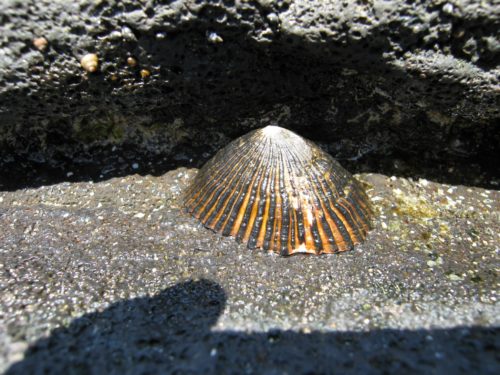
Photo credit: Troy McKasle
On the mainland many people know there are limpits, if they are familiar with them at all. They are found on waters edge clinging tightly to rock surfaces. In Hawaii it is often dangerous to gather them as they are more abundant in hard to reach and moderately dangerous locations as easy to get to spots are often picked over. Gathering shellfish that are clung tightly to rocks that aren’t in a hurry to let go while waves are doing their best to push you into sand rocks, makes for a rather dangerous endeavor. Instead of gathering them yourself they can be purchased, however they often command a rather high price. Best eaten raw with a little hot sauce or squeeze of citrus.
Li Hing Mui
Li hing mui is made from a dried plum that has a rather strong sour flavor. Having it for the first time is a bit shocking as it’s s taste you’ve never likely had before, salty, sour and sweet all at once. The dried plums can be purchased whole with seeds inside, best nippled slowly. They are also often made into a powder to coat other things such as dried mango.
Shaved Ice
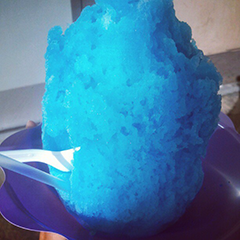
It’s not uncommon to find shaved ice on the mainland, not to be confused with snow cones which is more ground ice and doesn’t even compare. Even so it’s best eaten in Hawaii as they are the ones that popularized it and in turn perfected it. Places abound that sell this delicious cold treat and all locals have their favorite spot, generally out of the way non-tourist locations. Ask around and take a trip to a locals favorite spot to get your shaved ice if you get to a spot and you’re the only tourist, then you’re probably in the right spot. Generally topped with fruit syrup you’ll also find it popularly served with sweetened condensed milk, don’t skip on this topping as it takes this sweet treat to another level.
Fruits
Fruits abound in Hawaii, surprise surprise tropical fruits are what you’re most likely to find. And not just pineapple, which Hawaii of course has in abundance. Other fruits like mangos, dragon fruit and papaya can’t be found riper or tastier than what you’ll find on the island. Dragon fruit being the most unique of the three is a white or pink fruit with a beautiful flower like skin. They must be eaten at their optimal ripeness as otherwise they can be a bit bland. Flavor is enhanced with a squirt of lime, which also goes great on sliced papaya.
There are many great foods and dishes you’ll find in Hawaii as it’s truly one of a kind food culture. The food alone is worth a visit.
